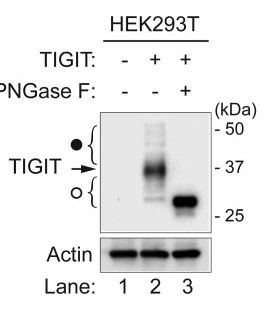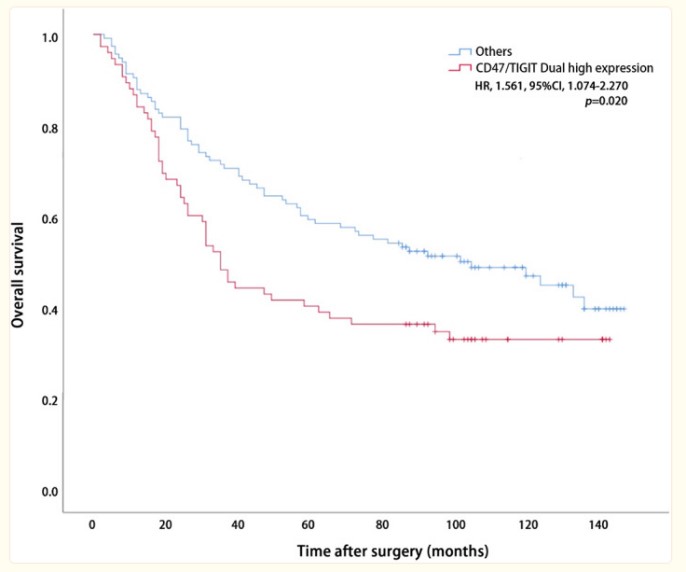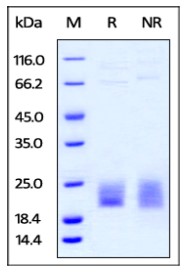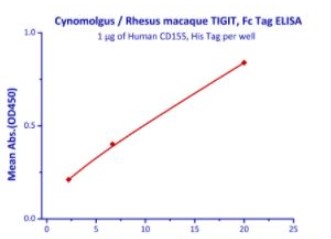TIGIT
-
Official Full Name
T cell immunoreceptor with Ig and ITIM domains -
Overview
This gene encodes a member of the PVR (poliovirus receptor) family of immunoglobin proteins. The product of this gene is expressed on several classes of T cells including follicular B helper T cells (TFH). The protein has been shown to bind PVR with high affinity; this binding is thought to assist interactions between TFH and dendritic cells to regulate T cell dependent B cell responses. -
Synonyms
TIGIT;T cell immunoreceptor with Ig and ITIM domains;V set and immunoglobulin domain containing 9 , V set and transmembrane domain containing 3 , VSIG9, VSTM3;T-cell immunoreceptor with Ig and ITIM domains;DKFZp667A205;FLJ39873;V-set and transmembrane domain containing 3;V-set and immunoglobulin domain containing 9;Washington University cell adhesion molecule;V-set and transmembrane domain-containing protein 3;V-set and immunoglobulin domain-containing protein 9;VSIG9;VSTM3;WUCAM
Recombinant Proteins
- Human
- Mouse
- Cynomolgus/Rhesus macaque
- Rat
- Cynomolgus
- Rabbit
- Mus musculus
- Canine
- Rhesus Macaque
- HEK293
- Human Cells
- E.coli
- CHO
- Mammalian Cells
- HEK293T
- Fc
- His
- Avi
- GST
- Non
- mFc
- T7
- DDK
- Myc
- Flag
- SUMO
Background
What is TIGIT protein?
Discovered in 2009, the T cell immunoreceptor with Ig and ITIM domains (TIGIT) has emerged as an essential player in the immunosuppression scene. This protein is a vital member of the immunoglobulin superfamily, known for their role in immunity, cell-cell recognition, and cell surface receptors.
Chronologically, Hafler's team initially discovered the TIGIT protein during research investigating the mechanisms regulating immune responses in multiple sclerosis. Through the genetic sequencing of T-cells, the team unveiled the existence of the TIGIT gene.
TIGIT gene locus is located on chromosome 3q13.31. This gene encodes a protein comprising two immunoglobulin (Ig) domains, a transmembrane domain, and an immunoreceptor tyrosine-based inhibitory motif (ITIM). The protein structure is distinct and systematic with an N-terminal IgV domain, playing a crucial role in binding to its ligands, followed by a C2-type Ig domain without a known function.
Functions of TIGIT Protein
Expressed primarily on immune cells, predominantly T cells, natural killer (NK) cells, and Regulatory T cells, TIGIT plays a cardinal role in the immune system's function. TIGIT works as a checkpoint inhibitor, meaning it can impede immune responses, allowing cancer cells to grow undeterred, hence its association with diseases such as cancer.
Prominently, TIGIT competes with another co-stimulatory receptor, CD226, for binding to the nectin and nectin-like families. TIGIT's affinity for these families is high, leading to the suppression of the immune response usually prompted by CD226 binding to the same ligands. When TIGIT binds to CD155 or CD112, an inhibitory signal is sent to the immune cells, suppressing the immune response.
TIGIT-Related Signal Pathway
The signaling pathway of TIGIT is vital to understanding its comprehensive function. Once bound to its ligands, TIGIT exhibits its ITIM and ITT-like motifs and recruits the protein tyrosine phosphatases SHP1 and SHP2. This initiation interferes with the downstream signaling pathways, ultimately leading to decreased immune cell activation and secretion of certain cytokines, dampening the immune response.
TIGIT-related Diseases
The in-depth study of TIGIT revealed its association with several diseases. Most notably, it's tied to malignancies like melanoma, colorectal cancer, breast cancer, and hematological cancers. The elevated expression of TIGIT has been recognized on tumor-infiltrating T cells and associated with a significantly worse prognosis across various cancers.
Also, TIGIT has been implicated in autoimmune and infectious diseases. For instance, TIGIT expression is found to be upregulated in CD4 + T cells in Multiple Sclerosis, Rheumatoid Arthritis, and Type 1 Diabetes patients. TIGIT's inhibitory role has raised the question about the protein's role in the evolution of chronic viral infections, considering its expression is upregulated on T cells during viral infections.
- Cancer: Expression of TIGIT ligands by tumors inhibits anti-tumor T cells, promoting immune evasion. Blocking TIGIT can enhance immune-based cancer therapies.
- Chronic infections: Persistent pathogens like HIV, HCV, HBV induce TIGIT expression, contributing to T cell exhaustion and dysfunctional immunity.
- Autoimmunity: Upregulation of TIGIT helps prevent autoimmune pathology by maintaining tolerance of self-reactive T cells in tissues.
- Transplant rejection: TIGIT signaling inhibition may improve transplant acceptance by regulating alloreactive T cell responses against donor antigens.
- Cancer immunotherapy: Antibodies blocking TIGIT/CD155 interaction aim to reverse T cell exhaustion and boost anti-tumor immunity.
- Transplantation: TIGIT inhibitors given with other immunosuppressants may help acceptance of transplanted organs by modulating allograft-reactive T cells.
- Vaccine adjuvant: TIGIT blockade enhances T cell responses and memory induction, improving efficacy of vaccines for chronic infections.
Due to its function as an inhibitory immune checkpoint, the TIGIT protein has become an appealing target for immunotherapy, particularly in cancers. This approach aims to block TIGIT's inhibitory effects to allow an enhanced immune response against cancer cells. Numerous pharmaceutical companies are currently in a race to develop anti-TIGIT therapies, with several anti-TIGIT antibodies in clinical trials for various cancers.
Furthermore, TIGIT protein could have potential applications in treating autoimmune disorders. By harnessing the inhibitory properties of TIGIT, therapies could be developed to reduce the overactive immune responses seen in autoimmune diseases.
- Cancer immunotherapy: Antibodies blocking TIGIT/CD155 interaction aim to reverse T cell exhaustion and boost anti-tumor immunity.
- Transplantation: TIGIT inhibitors given with other immunosuppressants may help acceptance of transplanted organs by modulating allograft-reactive T cells.
- Vaccine adjuvant: TIGIT blockade enhances T cell responses and memory induction, improving efficacy of vaccines for chronic infections.
Case Study

(Yu-Xi Lin, 2021)
Fig3. Western blotting analysis of full-length TIGIT-transfected HEK293T cell lysates with or without PNGase F treatment. The 37-kDa fraction of TIGIT is indicated by arrowhead. The fractions above and below the 37-kDa fraction are indicated by black and white circles, respectively.

(Yue Peng, 2022)
Fig4. Kaplan–Meier curves for 190 LUSC cases from our center categorized by TIGIT/CD47 dual expression status. CD47, cluster of differentiation 47; LUSC, lung squamous cell carcinoma; TGA, The Cancer Genome Atlas; TIGIT, T cell immunoreceptor with immunoglobulin and ITIM domains
Quality Guarantee
High Purity

Fig1. SDS-PAGE (Cat. No.: TIGIT-360H)
High Bioactivity & Detection Sensitivity

Fig2. The protein has a calculated MW of 40.0 kDa. The protein migrates as 45-55 kDa under reducing (R) condition (SDS-PAGE) due to glycosylation.
Involved Pathway
TIGIT involved in several pathways and played different roles in them. We selected most pathways TIGIT participated on our site, such as Cell adhesion molecules (CAMs), which may be useful for your reference. Also, other proteins which involved in the same pathway with TIGIT were listed below. Creative BioMart supplied nearly all the proteins listed, you can search them on our site.
| Pathway Name | Pathway Related Protein |
|---|---|
| Cell adhesion molecules (CAMs) | NRXN1A,CLDNB,CLDN8,CLDN4,ITGB2,HLA-DOB,ITGAL,ITGB1A,F11R,CLDNA |
Protein Function
TIGIT has several biochemical functions, for example, cell adhesion molecule binding,protein binding,protein homodimerization activity. Some of the functions are cooperated with other proteins, some of the functions could acted by TIGIT itself. We selected most functions TIGIT had, and list some proteins which have the same functions with TIGIT. You can find most of the proteins on our site.
| Function | Related Protein |
|---|---|
| receptor binding | EFNA1,CXCL1,FGF24,CNPY3,IDUA,CAPRIN2,ANG,PVRL1B,GCG,MCHR1 |
| receptor activity | ANXA2R,GRIA4B,NLGN2B,CADM3,ITGAX,KRT1,CXCR3,CSF2RB,CSF3R,PVRL1A |
| cell adhesion molecule binding | CADM1A,FGG,CDH1,PVRL3B,PKP3,CPE,PVRL1,DSP,POSTN,PTBP3 |
| protein homodimerization activity | Trl,DCK,MAP3K10,NTRK2,ABCD3,ERBB4,CASQ2,SMAGP,IKZF4,NPM1 |
| protein binding | NAA30,RAD51L3,SLC22A17,JIP1,RAET1D,DDX41,NIPAL3,PMAIP1,HNRNPL,PSMA1 |
Interacting Protein
TIGIT has direct interactions with proteins and molecules. Those interactions were detected by several methods such as yeast two hybrid, co-IP, pull-down and so on. We selected proteins and molecules interacted with TIGIT here. Most of them are supplied by our site. Hope this information will be useful for your research of TIGIT.
CD226;PVR;PVRL2;PVRL4;PVRL3
Resources
Research Area
Related Services
Related Products
References
- Johnston, RJ; Comps-Agrar, L; et al. The Immunoreceptor TIGIT Regulates Antitumor and Antiviral CD8(+) T Cell Effector Function. CANCER CELL 26:923-937(2014).
- Zhang, T; Wang, JH; et al. Increased Expression of TIGIT on CD4(+) T Cells Ameliorates Immune-Mediated Bone Marrow Failure of Aplastic Anemia. JOURNAL OF CELLULAR BIOCHEMISTRY 115:1918-1927(2014).




